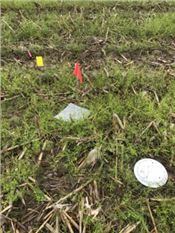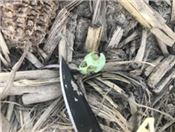Rye Cover Crops Attract Good Insects With Minimal Impact From Pests
URBANA, ILL.
Cover crops are an effective tool for reducing soil erosion, nutrient losses, and leaching, and remain a key piece of the Illinois Nutrient Loss Reduction Strategy. However, farming practices over the past several decades decreased the quantity of cover crops, causing low water infiltration and runoff into waterways, according to the Midwest Cover Crops Council.
A two-year study by Nick Seiter, University of Illinois Extension crops specialist, finds cereal rye cover crops have a positive impact on pests and beneficial insect populations in Illinois.
To inform farmers on pest management recommendations for cover crop systems, Seiter studies a combination of cereal rye on commercial fields, existing NREC-funded research sites, and new field experiments.
Several Illinois Extension educators assisted with field research by setting up different types of insect traps, bagging the captured insects at weekly intervals and transporting the insect samples back to the Illinois campus for identification.
Traps were set in both cover crop and non-cover crop fields to look at potential differences in insect populations.
Some farmers are apprehensive of trying cover crops in their operation, with one of their concerns being potential insect issues, says Duane Friend, Extension educator and collaborator on the project.
“By examining what insects are present in a cover crop setting, both harmful and beneficial, would provide vital information for producers to determine if cover crops would be viable for their operations,” says Friend.
The results from 73 commercial soybean fields indicate that none reached an economic threshold for insect control. The additional risk of insect pest problems appear to be relatively low in Illinois.
“Not only did we not see any economic damage from insects in Illinois fields, but there was no economic damage in soybean fields in the five other states,” Seiter says. “This is good news for farmers who are looking to adopt these systems to mitigate erosion, nutrient loss, waste control, and weed controls.”
This summer, Brodie Dunn, graduate student in crop sciences at the University of Illinois, plans to submit and defend his thesis based on the impact of cereal rye cover crops and pests on the use of agricultural fields by various bird species.
Together, Seiter and Dunn will contribute to a national study evaluating the impacts of rye termination timing on insect, disease, and weed management and conduct future research regarding residue management practices for slugs in Spring 2022.
“Farmers and crop advisors are most concerned about slugs, which can be an issue in no-till, heavy residue systems with cereal rye,” says Seiter. “Cover crops could certainly qualify for this problem.”
Seiter hopes the new research will help farmers save money and explore new prevention strategies due to minimal chemical treatments.
“This research and collaboration between Extension educators and researchers on campus is exactly what the Extension model is meant to do,” Friend says. “Following the research, we are providing the information to farmers to use in their management decisions.” ∆

Extension researchers used insect traps in cereal rye fields to measure the damage impact. This photos shows a sticky trap to capture small flying insects,
shingle trap to capture slugs, and a pitfall trap to capture ground-dwelling pest and beneficial arthropods.

This soybean cotyledon shows damage from slugs.
Extension Photos by Jennifer Jones